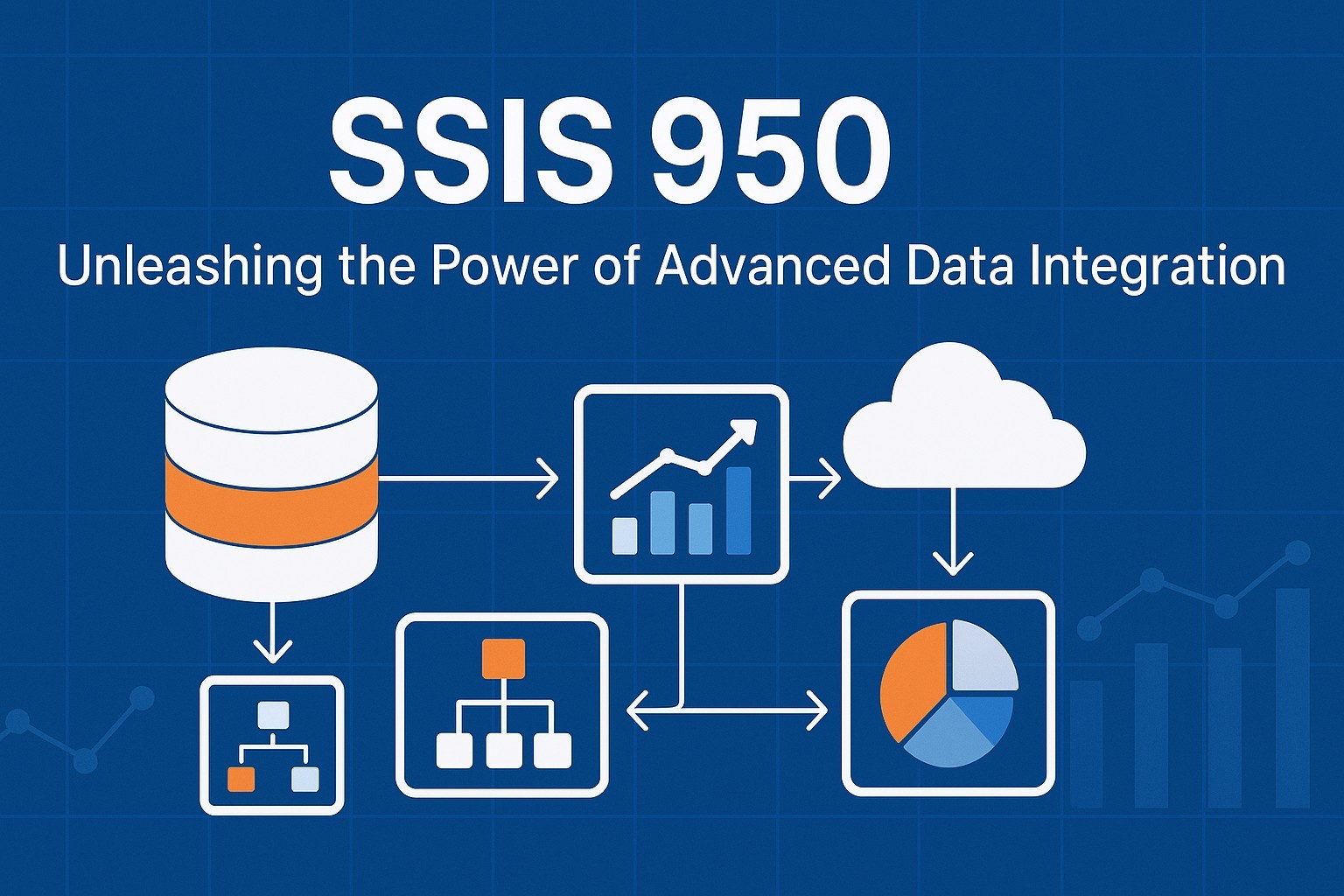In today’s digital-first world, data flows like electricity—powering decisions, driving strategies, and ensuring businesses stay competitive. But raw data is messy. It comes from various places, in countless formats, and with its own unique set of problems. That’s where SSIS 950 steps in—not just as another version update, but as a vital toolset for mastering intelligent data integration.
Whether you’re a data engineer, BI developer, or just someone trying to elevate your organization’s data pipeline, understanding SSIS 950 could be your career’s turning point. So, let’s decode this powerful system and explore how it supercharges workflows and reshapes the future of data transformation.
What is SSIS 950? A Quick Overview
SSIS 950 refers to a high-level tier or build of SQL Server Integration Services (SSIS), Microsoft’s ETL (Extract, Transform, Load) tool designed to handle complex data integration tasks. At this level, SSIS offers enhanced performance, compatibility, and advanced capabilities for enterprise-grade data projects.
It’s not just about loading data anymore—SSIS 950 is about orchestrating seamless integration, automating workflows, handling large volumes efficiently, and introducing intelligent logic that responds to your organization’s evolving needs.
Why SSIS 950 Matters in 2025
The modern business landscape demands more than just structured data movement—it expects speed, intelligence, and real-time decisions. SSIS 950 answers this call by:
Supporting hybrid data sources (on-premises and cloud)
Enabling scalable data flows
Providing robust error handling and logging
Supporting parallel processing
Integrating with Azure and other cloud-based services
In other words, SSIS 950 is not just a tool—it’s an enabler of smart data ecosystems.
Key Features That Set SSIS 950 Apart
Here’s why data professionals are talking about SSIS 950:
Enhanced Performance Optimization
Built-in capabilities help minimize memory consumption, and allow multi-threaded execution for faster transformations.
Extended Connectivity
Connect easily to APIs, REST services, flat files, legacy systems, SQL databases, and cloud services such as Azure Blob, AWS S3, and Google BigQuery.
Improved Debugging & Logging
SSIS 95’0 provides better debugging tools and built-in logging mechanisms, helping developers quickly identify and fix issues.
Visual Development Interface
Its drag-and-drop UI and real-time previewing allow users to build and troubleshoot packages without writing extensive code.
Custom Script Support
Need more flexibility? Use C# or VB.NET to write custom transformations or control flows.
Data Integration in Action: Use Cases of SSIS 950
Wondering how SSIS 95’0 works in the real world? Here are a few examples:
E-commerce Platforms
SSIS 95’0 can connect online shopping systems with back-end databases, synchronize inventory, and generate daily performance reports.
Healthcare Data Management
Pulls patient data from various hospital systems, standardizes it, and pushes it into analytics platforms for insights into patient care.
Financial Institutions
Streamlines reporting by collecting data from various transaction systems, applying transformations, and storing in secure, compliant databases.
Educational Institutes
SSIS 95’0 integrates student data across departments, enabling unified dashboards for administration.
The Architecture Behind SSIS 950
SSIS follows a modular structure. Here’s a breakdown of its building blocks:
Control Flow: Defines the order of execution for various tasks like loops, conditionals, and calls to data flow.
Data Flow: Handles actual data operations like extraction, transformation, and loading.
Package: A complete unit containing all control and data flow elements.
Parameters & Variables: Customize package behavior for dynamic execution.
Event Handlers: Allow responses to specific runtime events such as errors or completion.
SSIS 95’0 builds on these fundamentals with deeper Azure integration, performance tuning tools, and modernized deployment models.
Best Practices for Using SSIS 950 Effectively
To make the most of SSIS 95’0, here are some expert-backed best practices:
Use Project Deployment Model
It enables centralized configuration and easy version control across environments.
Parameterize Connections
Avoid hardcoding values. Instead, use parameters and environment variables to keep your packages flexible.
Partition & Parallelize
Divide large datasets and run tasks in parallel to reduce execution time.
Implement Robust Logging
Use event handlers and logging to monitor package execution and catch failures early.
Avoid Unnecessary Transformations
Perform transformations only when needed. Unoptimized packages slow down execution.
✔Regularly Optimize Data Flows
Monitor buffer sizes, row counts, and component designs to maintain performance.
Career Impact: Why You Should Master SSIS 950
Mastering SSIS 95’0 doesn’t just enhance your technical skillset—it can transform your career.
High Demand for Data Professionals
Data engineering roles are growing rapidly, and SSIS remains one of the top tools companies look for.
Cross-Industry Relevance
SSIS 950 is used across retail, finance, healthcare, logistics, education, and government sectors.
Higher Salary Potential
Professionals with SSIS experience, especially at the 95’0 level, often command higher salaries and leadership roles in data teams.
Certification & Learning
Microsoft offers certifications that include SSIS, and mastering 95’0 prepares you for high-level exams and project responsibilities.
Deployment Models Supported in SSIS 950
SSIS 95’0 supports two major deployment models:
Project Deployment Model
Ideal for modern DevOps pipelines. Packages are grouped and deployed together, simplifying configuration and version control.
Package Deployment Model
More traditional and suitable for small-scale, independent package execution scenarios.
Cloud deployment is also simplified in SSIS 95’0, with native Azure Data Factory compatibility.
Future of Data Integration with SSIS 950
The integration landscape continues to evolve, and SSIS 95’0 is keeping pace with the trends:
-AI & ML Integration: Data prepared by SSIS is feeding predictive analytics and intelligent applications.
-Real-Time Data Flows: With event-driven triggers and streaming data support, SSIS 95’0 is venturing into real-time integration.
-Data Governance: Enhanced metadata and auditing tools help organizations comply with regulations like GDPR and HIPAA.
As businesses lean more into digital transformation, SSIS 95’0 provides the foundation they need for reliable, automated, and insightful data operations.
Conclusion
SSIS 950 is not just another version—it’s a leap forward in data integration. With its scalable architecture, improved performance, and cloud compatibility, it has become a cornerstone for data professionals seeking to manage complex pipelines efficiently.
Whether you’re building enterprise-level applications or simplifying data migration processes, mastering SSI’S 950 puts you in control of your organization’s most valuable asset—data.
Get ahead of the curve. Embrace SSIS 95’0 and unlock the full potential of your data integration journey.
FAQs About SSIS 950
What is SSIS 950 used for?
It’s used for integrating, transforming, and loading data from various sources into target systems.
Is SSIS 95’0 different from older SSIS versions?
Yes, it offers enhanced performance, better cloud integration, and advanced debugging features.
Can SSIS 950 work with Azure?
Absolutely. SSIS 950 supports Azure Data Factory and Azure-SSIS IR for seamless cloud deployment.
Is SSIS 950 suitable for beginners?
While it has advanced features, the visual tools and user-friendly UI make it accessible for newcomers.
What programming languages does SSIS 950 support?
It supports C# and VB.NET for custom scripting within tasks and components.
Do I need SQL Server to use SSIS 950?
Yes, SSIS is part of the SQL Server suite, although it can integrate with many other data systems.

